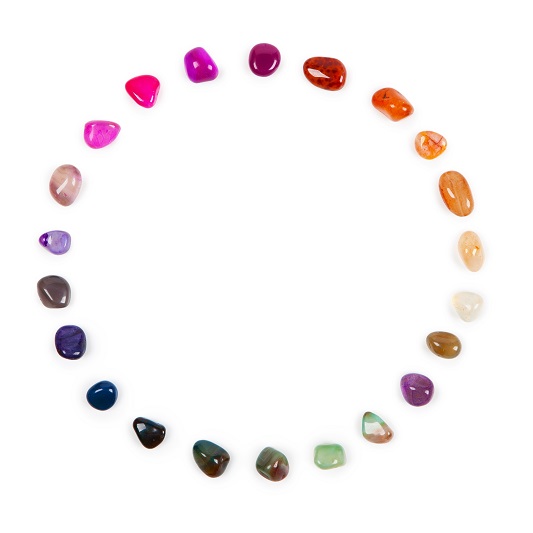Gemstone of the Week: Lapis Lazuli

Gemstone of the Week – Tourmaline
12th January 2018
Onyx Gemstone of the Week
26th January 2018Lapis Lazuli, or just ‘Lapis’ as it’s often referred to, has been a popular gemstone for thousands of years. ‘Lapis’ is a traditional Latin word that translates to ‘stone’, and derives from the Arabic and Persian name for the Lapis stone, which was ‘Lazaward’. Typically, Lapis boasts an intense blue colour. Various locations around the world have named words for the colour ‘blue’ after the stone; for instance, the English word ‘azure’. Fine-quality Lapis is still considered to be one of the most favourable blue gemstones. The stone itself typically forms in crystalline marble. Due to its chemical composition, it is technically classed as a rock rather than a mineral. The primary chemical in the stone is lazurite, while other trace minerals make up the remaining composition. These are usually a mixture of calcite, sodalite, and pyrite; the final colour of the specimen is influenced by these amounts. Below, we explore Lapis Lazuli in more detail.
How to Identify Lapis Lazuli
As mentioned previously, a specimen of Lapis Lazuli is primarily composed of lazurite; the exact amount in each stone varies, but the percentage usually falls somewhere between 30% and 40%. Trained professionals will be able to identify Lapis through its chemical composition alone. Sometimes, Lapis can be confused with other gemstones such as azurite and sodalite. As all of these gems are blue opaque stones, it can be difficult for non-professionals to distinguish between the three. However, identification is simple if you know what you’re looking for. Azurite has a much lower hardness that Lapis and is usually a darker shade of blue. Sodalite, on the other hand, typically has a much lighter colouring.
Different Colours and Types of Lapis Lazuli
While Lapis stones are always blue in colour, the exact hue of each specimen may vary. Ranging from deep royal blue to turquoise blue-green, the colour of each gem is influenced by the levels of trace impurities. Lazurite, the main component of Lapis, produces the intense royal blue colour. Trace minerals such as afghanite create a pale blue shade, instead.
For the most part, Lapis boasts a royal blue colour with a slightly greenish tint. Fine-quality Lapis has is highly saturated and has no visible calcite. While fine-quality specimens may contain flecks of pyrite, these are gold and attractive in appearance, therefore, they don’t necessarily lower the value of the stone. However, if Lapis has an excess of pyrite, the stone will appear dull and green. Specimens of this nature are classed as the lowest-quality.
As with all gemstones, Lapis holds a variety of different trade names. Typically, these names are based on the colour of the stone, along with the presence or absence of pyrite and calcite. Below, we explore some of the most popular types of Lapis on the market today.
Persian/Afghan
Persian or Afghan Lapis is classed as the highest quality. This type of stone contains almost no calcite or pyrite, meaning the gemstone appears flawless. Usually, Persian or Afghan Lapis is an intense shade of blue with a violet tint.
Russian/Siberian
Russian or Siberian Lapis always contains pyrite and may contain a small amount of calcite, too. Gemstones of this type appear in various different tones of blue.
Chilean
Chilean Lapis is regarded as the lowest-quality. This type of stone contains a high level of calcite and is usually dull and green in appearance.
Where is Lapis Lazuli Found?
First discovered over 6000 years ago, Lapis was originally found in the West Hindu-Kush Mountains in Afghanistan. Today, Afghanistan is still the biggest source of Lapis, with most deposits being fine-quality and holding a high-value. Lapis is also found in various other locations worldwide; notable sources include Angola, Argentina, Canada, Chile, India, Italy, Myanmar, Pakistan, Russia and the United States.
Healing Properties of Lapis Lazuli
Often regarded as a stone of protection, Lapis Lazuli can be used to prevent bad-fortune within everyday life. The gem is also thought to release stress, bringing with it a sense of relaxation and peace. Working to increase self-awareness and encourage self-expression, Lapis can be used to improve honesty, compassion, and morality; in light of this, Lapis is a popular stone to use within relationships. Inspiring confidence and encouraging one to speak their mind, the precious gemstone may help to bond relationships of all sorts by allowing individuals to express their true feelings and emotions.
Physically, Lapis Lazuli can purify the blood, lower blood pressure, and even strengthen the immune system. The stone is also thought to benefit inflammation, working to cool and soothe areas of discomfort. Minimising symptoms of insomnia and helping to overcome depression, Lapis is ideal for those having trouble sleeping. When fighting depression, Lapis is best used in conjunction with other medication or treatments advised by a medical professional.
Lapis is also thought to improve analysis skills, making the stone perfect for historians, psychologists, and archaeologists. Aiding problem-solving in the workplace, the precious gemstone may benefit inventors, lawyers, and even creatives.
In Summary
Fine-quality Lapis Lazuli is loved all around the world. Today, the highest-quality specimens are sourced from Afghanistan; with an intense blue hue and saturated appearance, Afghan Lapis brings with it a hefty price tag. Popular for its diverse range of shades and opaque nature, gem-quality Lapis is often used in gemstone jewellery. Whether you’re hoping to use the stone for its benefits within crystal healing or you’re looking for a beautiful new addition to your jewellery collection, purchase a good-quality piece of Lapis Lazuli to reap the benefits.




